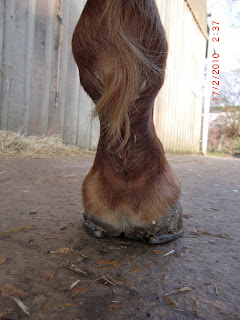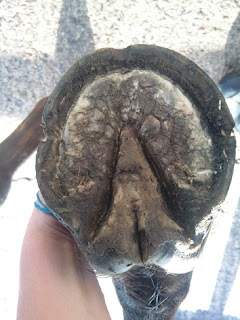I want to show how if there are metabolic, physical or stress issues these have to be dealt with as part of the transition. When a horse is not 'whole horse' healthy, it is likely to show in the feet and even the best trim in the world can't fix a poor diet or a stressful environment.
Just deshod, flare and stress rings clearly evident

Today, the foot is in better shape, but the lower two thirds is full of stress rings. The last big ring about 1/3 the way down was from when she had an allergic reaction to a vaccination.

Just deshod, heel contraction clearly evident

Today, foot decontracted

At least two severe laminitic episodes are evident in the stress rings. It would appear there was some separation. (I used off fore for this shot because the picture was much clearer, but both fores are the same)

The separation has grown out and the foot is a much better shape, but there are still stress rings, albeit much fainter than before

Just deshod - this foot is a mess of shedding sole, lack of trimming and thrush, it is misleading as to the true picture of what is going on with the foot

A bit later, the sole has shed out (this was not trimmed), the overlaid bars were trimmed and the wall tidied up and rolled. This picture shows how 'sick' the wall is. Very thin with little water line - it disappears altogether in the back half of the foot. The sole is completely flat, with very little depth to the collateral groove. The shape is more indicative of a hind, but its actually the near fore.

Same foot now. The heels have broadened, the shape is rounder and although its hard to see in this photo there is more depth to the foot.

But holistically this is still a sick horse. If you looked at her in the 'traditional' way you might not think so - her coat is shiny, she eats well, her eyes are bright and full of interest.
It's really easy to lame a horse with a bad trim, but the best trim in the world won't fix a horse if the other aspects are not properly addressed.





















































